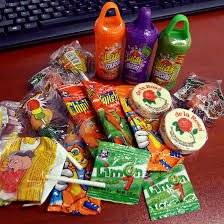Mexican candy is a vibrant and diverse category of confections that reflect the rich cultural heritage and culinary traditions of Mexico. These candies are renowned for their bold flavors, combining sweet, sour, salty, and spicy elements in unique and exciting ways. From traditional treats passed down through generations to modern innovations, Mexican candy offers a taste experience like no other.
Table of Contents
The Origins of Mexican Candy
The roots of Mexican candy can be traced back to ancient Mesoamerican civilizations, where indigenous peoples utilized native ingredients such as cacao, agave, and various fruits to create sweet treats. With the arrival of Spanish colonizers, new ingredients like sugar, cinnamon, and nuts were introduced, leading to the evolution of Mexican candy into the diverse assortment we enjoy today.
Popular Types of Mexican Candy
Tamarind is a staple in Mexican candy, offering a tangy and slightly sour flavor that pairs beautifully with chili powder and salt. Candies like Pelon Pelo Rico, a tamarind pulp candy, and Rellerindo, a tamarind-filled lollipop, are beloved for their bold taste and chewy texture.
Chili-Infused Sweets

Chili is a defining characteristic of many Mexican candy varieties. Candies such as Lucas Gusano, a gummy worm coated in chili powder, and Skwinkles, a tamarind-based treat dusted with chili, exemplify the harmonious blend of sweetness and heat that defines Mexican candy.
Sugar Skulls and Day of the Dead Treats
Sugar skulls, or “calaveritas de azúcar,” are traditional Mexican candy crafted for the Day of the Dead (Día de los Muertos) celebrations. These colorful, skull-shaped confections are decorated with vibrant icing and often inscribed with the names of deceased loved ones, serving as both a sweet offering and a decorative piece during the festivities. The origins of sugar skulls trace back to colonial influences from Italy and Spain, later incorporating into Mexican culture. Traditionally, they are used to adorn altars (ofrendas) created to honor deceased loved ones, featuring flowers, colorful papel picado, photos, and food. Sugar skulls are decorated with colorful icing and sometimes beads, and they usually display the name of the deceased on the forehead. citeturn0news22
Jarritos-Inspired Candies
Building on the popularity of Jarritos, a beloved Mexican soda brand, new Mexican candy products have emerged that capture the essence of the soda’s flavors. These candies, including gummies and lollipops in flavors like tamarind, mango, and lime, offer a nostalgic taste experience reminiscent of enjoying an ice-cold Jarritos on a hot day. citeturn0news13
Chamoy and Pickle Candy Kits
A recent trend in Mexican candy involves chamoy-soaked pickles filled with various candies. Originating from San Antonio, these DIY kits allow enthusiasts to create their own spicy, tangy, and sweet concoctions, reflecting the innovative spirit of Mexican candy culture. The viral TikTok chamoy pickle kit trend, which features bright red pickles filled with candies, has its origins in San Antonio. This trend has significantly boosted local businesses, particularly Casa Dulce, owned by Joey Hernandez, where sales of the needed ingredients have doubled. Chamoy and sour candies are popular in South Texas and Mexico, but the trend is credited to San Antonio’s CandyMex Express, whose TikToks popularized the treats. Customers buy DIY kits via TikTok Shop or in person, containing chamoy-soaked pickles and candies to wrap and stuff the pickles. Videos featuring this trend have millions of engagements. The trend has also spread internationally, with TikTok users in Australia participating. This phenomenon not only drives local business but also celebrates Mexican culture. citeturn0news14
Where to Buy Mexican Candy
For those interested in exploring Mexican candy, several online retailers offer a wide selection. Websites like Amazon, Walmart, and specialty candy shops provide variety packs and individual treats, making it easy to sample different flavors and find favorites. Additionally, local Mexican grocery stores often carry an assortment of Mexican candy, providing an authentic shopping experience.
Conclusion
Mexican candy is more than just a sweet indulgence; it is a reflection of Mexico’s rich cultural tapestry and culinary creativity. Whether you’re savoring the tangy zest of tamarind, the fiery kick of chili, or the nostalgic flavors of Jarritos-inspired treats, Mexican candy offers a delightful journey into the heart of Mexican cuisine and tradition.
FAQs About Mexican Candy

Mexican candy is distinguished by its bold combination of sweet, sour, salty, and spicy flavors, often incorporating indigenous ingredients like tamarind and chili.
Can I find Mexican candy outside of Mexico?
Yes, many online retailers and local Mexican grocery stores worldwide offer a variety of Mexican candy, making it accessible to enthusiasts everywhere.
Are there vegan or gluten-free Mexican candies?
Some Mexican candy options are vegan or gluten-free, but it’s important to check ingredient labels or consult with the retailer to ensure suitability for specific dietary needs.
How should I store Mexican candy?
To maintain freshness, store Mexican candy in a cool, dry place, away from direct sunlight. Some candies may require refrigeration, so it’s advisable to check packaging instructions.
Also read Barbers Near Me Your Ultimate Guide to Finding the Best Barbershops
Can I make Mexican candy at home?
Absolutely! Many traditional Mexican candy recipes are available online, allowing enthusiasts to recreate favorites like tamarind pulp candy or chili-coated gummies in their own kitchens.


